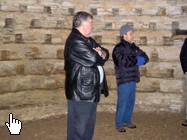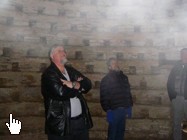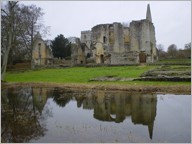
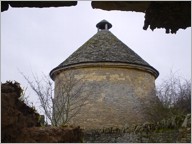
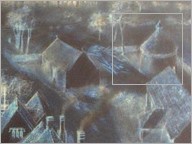
While on holiday during the festive season of 2003, I visited the ruins of Minster Lovell Hall, in Oxfordshire, England, UK. Beyond the stunning medieval ruins stands the ‘dovecote’, a practical building used to house doves. After exploring and photographing the main ruin I walked towards the Dovecote and entered the building through a small door in its base. Immediately struck by the darkness inside, I glanced upwards to the opening in the structure above. Switching the digital cameras flash function on I took a photograph of the exquisitely detailed roof structure. I viewed the image using the cameras LCD screen, and then decided to take another snap. Nothing appeared in the viewfinder when lining up the frame, but when I glanced at the LCD I was surprised (and a little shocked) to see the image had changed dramatically.....

First digital photograph, taken in the Minster Lovell Hall ‘Dovecote’.
Time : 12:33pm, 25/12/03
Click image to view larger version.
Second digital photograph, taken in the Minster Lovell Hall ‘Dovecote’.
Time : 12:33pm, 25/12/03
Click image to view larger version.

As a writer of supernatural fiction, some may suggest I am easily ‘taken in’ by anything that seems out of the ordinary, but this really isn’t the case. I am, actually, a sceptic at heart. Much like the ‘Scully’ character in the US sci-fi series “The X-Files” I am interested in ghosts and supernature, but need hard evidence to prove what I am seeing is really of paranormal origin rather than a leap of faith into fanciful theories. My intent on Christmas Day 2003 was not to go “ghosthunting” but rather to enjoy the Oxfordshire countryside and the stunning ruins at Minster Lovell (of which I knew nothing previously), so the photograph you have viewed (above) was taken as a holiday snap. The atmosphere, when I entered the Dovecote, was as expected: a small, dark space was naturally eerie and silent but otherwise quite normal (if aesthetically pleasing).
The first photograph looked good via the LCD screen on the digital camera, (a nice composition of beams and tiling), so I took a second snap. Viewing the second image via the LCD made the hairs on my neck stand on end. I am not too proud to admit that I got out of that space very quickly, and stood outside wondering what it was that had just occurred. I was tempted to re-enter the Dovecote to pursue the matter further, but lacked the necessary bravado. I did, however, perform two simple tests. The first involved taking further photographs to repeat the effect (which didn’t happen) and the second was to breath in and out several times to check it wasn’t my own breath being recorded. This winter, in Oxfordshire at least, has been surprisingly mild so no such condensation was visible. Even so, the pattern of the “wisp” is appearing to the right-hand side of the frame, rather than directly below. So, I rule out that possible cause.
If I were viewing the images, and had nothing to do with the evidence, I would immediately think the effect was caused by smoke. It certainly looks like smoke, perhaps from a cigarette. I do smoke, but my last cigarette that day was consumed in the carpark some 20 minutes beforehand.
So, where does this leave us? I wouldn’t want to state that the Dovecote at Minster Lovell is haunted, but this evidence goes some way to pursuading me that I wasn’t alone that Christmas Day afternoon.
_____________________________________________________________________________
Footnote: New Developments in November 2005
In January, 2006, I was contacted by Bruce Calgary (of Canada), who had this to offer:
I was interested in your Xmas 2003
picture of the smoke-like "ghost" in the dovecote at Minster
Lovell. I was there first in November 2004 and took some regular
boring pictures which showed nothing peculiar. In November 2005
however, these 2 photographs of myself and my mate Robin were taken
with my cousin's digital camera approx. 30 seconds apart, showing
a phenomenon similar to yours.
Bruce Eggertson
Calgary, Canada
It is interesting to note
how the 'mist' appears after the visitors had spent some time in
the Dove Cote, the time of year, and the 'descending' quality of
the 'mist' itself. These photographic examples are very similar
to the images captured back in 2003. Is there a spirit in the Dovecote,
who appears as a descending fog during the winter months.
A further converse with Bruce revealed that the weather, during
his visit to the Dovecote, was mild and sunny. There was no fog,
or mist, and the temperature was not suitable to produce condensation,
and visible breath. None of the party smoke cigarettes, and the
mist was not visible to the naked eye (although those present in
the image seem to be staring straight at it!). So, we are left with
a tantalizing re-appearance of the mists of Minster Lovell, but
are no closer to discovering their origins. Thanks to Bruce for
the images, and info. Minster Lovell is a wonderful ruin, and a
great place to ponder the supernatural.
A new investigation is planned for Minster Lovell in 2006.
_____________________________________________________________________________
Upon returning to London, I have carried out a little research on Minster Lovell Hall, and discovered two fascinating (if spooky) tales attached to the ruin, although I have found no specific mention of the Dovecote. It is interesting to note the similarities between these two legends....
The unluckiest owner of the house must surely have been Francis, 9th Baron Lovell, who started life a rich and powerful aristocrat and is said to have died in hiding in one of its vaults. Francis gambled his future on supporting the Yorkists in the War of the Roses - unlike his predecessor John, who was a Lancastrian. At first this change of sides brought rewards, an Francis was made a Viscount by Richard III in 1483. Two years later , Richard and his supporters were defeated at the Battle of Bosworth. Francis never gained the favour of the new king, Henry VII, and after an unsuccessful rebellion in 1487 he is said to have into hiding in a vault at Minster Lovell Hall (trusting the only key to a servant who died almost immediately). Two centuries later, in 1708, workmen making alterations to the house found ‘the entire skeleton of a man, as having been at a table which was before him with a book, paper, pen… all much mouldered and decay'.
Excerpt from 'Treasures of Britain' published 1968 by the AA
The 'Mistletoe Bough' legend dating from medieval times, is of a young girl who, during a game of hide and seek on Christmas Eve, hid in a heavy chest and was trapped; her skeleton was found years later.
Excerpt from ‘Illustrated Guide to Britain’ published by the AA
More on these stories can be found here.
Both before and after the Dovecote experience I took further images of Minster Lovell Hall. Click on one of the following images to view a larger version. The ruin is highly recommended to tourists interested in medieval architecture, and the paranormal.




These romantic ruins of a once grand 15th century manor house hide a very dark secret. The house was built between 1431-42 by the seventh Lord Lovell, Constable of Wallingford Castle. In the south west tower you can see the oriel window of the great chamber, probably added by the ninth and last Lord Lovell, Francis, who fought alongside Richard III at the battle of Bosworth.
Francis fled the field after Richard III was cut down by Henry VII's personal guard and, following a daring attempt to capture Henry VII at York, escaped to Flanders.
He was later to return to England with supporters of the imposter Lambert Simnel (the son of an Oxford joiner). This adventure ended in disaster at the fnal battle in the War of the Roses, at Stoke Field in 1486.
Legend has it that Lovell returned to the hall, where he hid himself away in a room that was only accessible from outside, with the entrance known only to a faithful retainer. The servant died suddenly, and before he was able to pass on the secret of his master's whereabouts.
The legend is given some credence in a letter written in 1737 by William Cowper, Clerk of the Parliament, to an antiquary, Francis Peck. Cowper relates that in 1708, when a new chimney was being built at Minster Lovell, "there was discovered a large vault or room underground in which was the entire skeleton of a man, as having been sitting at a table, which was before him with a book, paper, pen etc."
Cowper adds that the family believed the skeleton to be the remains of Francis Lovell "whose exit hitherto has been so uncertain."
Ten years after Cowper wrote this letter, the old house was dismantled (not very well, obviously! - Jonathan) by Thomas Coke, First Earl of Leicester, better known for building the great Palladian palace of Holkham in Norfolk.
© Newsquest (Oxfordshire) Ltd. 2003

